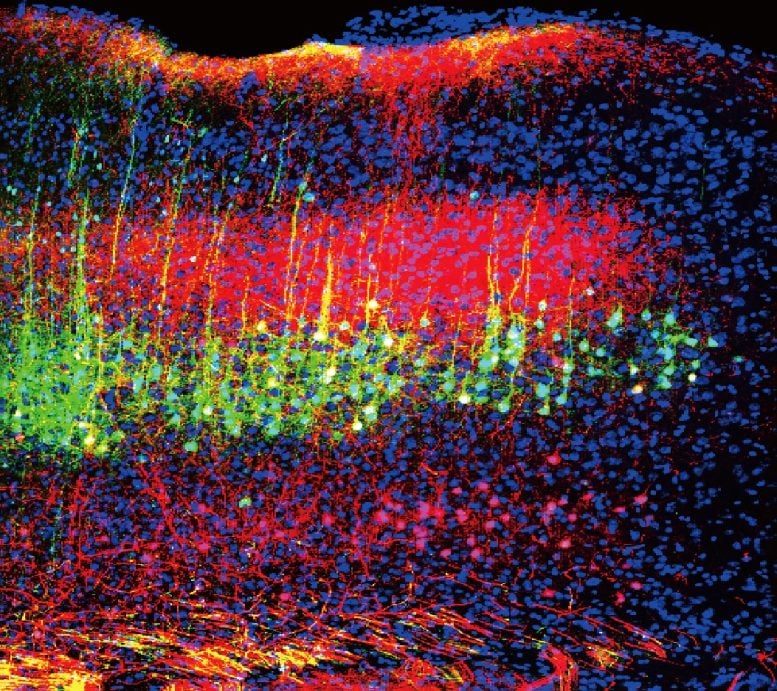
Scientists Discover How Sound Reduces Pain in Mice
The neural mechanisms through which sound blunts pain in mice have been identified by an international team of researchers. Published on July 7, 2022, in the journal Science, the findings could inform the development of safer methods to treat pain. The study was led by scientists at the National Institute of Dental and Craniofacial Research (NIDCR); the University of Science and Technology of China, Hefei; and Anhui Medical University, Hefei, China. NIDCR is part of the National Institutes of Health.
“We need more effective methods of managing acute and chronic pain, and that starts with gaining a better understanding of the basic neural processes that regulate pain,” said NIDCR Director Rena D’Souza, D.D.S., Ph.D. “By uncovering the circuitry that mediates the pain-reducing effects of sound in mice, this study adds critical knowledge that could ultimately inform new approaches for pain therapy.”
“We were really surprised that the intensity of sound, and not the category or perceived pleasantness of sound would matter.” Yuanyuan (Kevin) Liu, Ph.D.
Human studies dating back to 1960 have demonstrated that music and other types of sound can help relieve acute and chronic pain, including pain after dental and medical surgery, labor and delivery, and cancer. However, it was unclear how the brain generates this pain reduction, or analgesia.
“Human brain imaging studies have implicated certain areas of the brain in music-induced analgesia, but these are only associations,” said co-senior author Yuanyuan (Kevin) Liu, Ph.D., a Stadtman tenure-track investigator at NIDCR. “In animals, we can more fully explore and manipulate the circuitry to identify the neural substrates involved.”
Exploring the Neural Pathway from Sound to Pain Relief
The scientists first exposed mice with inflamed paws to three types of sound: a pleasant piece of classical music, an unpleasant rearrangement of the same piece, and white noise. Surprisingly, all three types of sound, when played at a low intensity relative to background noise (about the level of a whisper) reduced pain sensitivity in the mice. Higher intensities of the same sounds had no effect on animals’ pain responses.
“We were really surprised that the intensity of sound, and not the category or perceived pleasantness of sound would matter,” Liu said.
To explore the brain circuitry underlying this effect, the researchers used non-infectious viruses coupled with fluorescent proteins to trace connections between brain regions. They identified a route from the auditory cortex, which receives and processes information about sound, to the thalamus, which acts as a relay station for sensory signals, including pain, from the body. In freely moving mice, low-intensity white noise reduced the activity of neurons at the receiving end of the pathway in the thalamus.
In the absence of sound, suppressing the pathway with light- and small molecule-based techniques mimicked the pain-blunting effects of low-intensity noise, while turning on the pathway restored animals’ sensitivity to pain.
Future Pain Therapy Development
Liu said it is unclear if similar brain processes are involved in humans, or whether other aspects of sound, such as its perceived harmony or pleasantness, are important for human pain relief.
“We don’t know if human music means anything to rodents, but it has many different meanings to humans—you have a lot of emotional components,” he said.
The results could give scientists a starting point for studies to determine whether the animal findings apply to humans, and ultimately could inform the development of safer alternatives to opioids for treating pain.
Reference: “Sound induces analgesia through corticothalamic circuits” by Wenjie Zhou, Chonghuan Ye, Haitao Wang, Yu Mao, Weijia Zhang, An Liu, Chen-Ling Yang, Tianming Li, Lauren Hayashi, Wan Zhao, Lin Chen, Yuanyuan Liu, Wenjuan Tao and Zhi Zhang, 7 July 2022, Science.
DOI: 10.1126/science.abn4663
This research was supported by the NIDCR Division of Intramural Research. Support also came from the National Key Research and Development Program of China Brain Science and Brain-Like Intelligence Technology, National Natural Science Foundation of China, Science Fund for Creative Research Groups of the National Natural Science Foundation of China, CAS Project for Young Scientists in Basic Research, Natural Science Foundation of Anhui Province, and the University of Science and Technology of China Research Funds of the Double First-Class Initiative.
Never miss a breakthrough: Join the SciTechDaily newsletter.
2 Comments
Very interesting.
1. Wonder if such use of sound to suppress the pain signal using sound energy is as addictive as chemical pain relief technology in use currently.
2. Can other senses amenable to other forms of energy be useful in medical science?😊
Views are personal and not binding on anyone.
H i
not sure if this is of interest to anyone but since cuting a nerve in my forehead in an accident at work, damaging a nerve in my ankle after a bike accident and damaging nerves in my spine after crushing two discs and traping and damaging nerves i have found by using sounds of different types and closing my eyes and using headphones i can direct the tingles i get from nerve pain which feels like millions of ants on my body to most areas of my body that feeling pain- i use this technique to help over come pain in the stomache and pain in the lower back. i start by using stereo videos that send sound to both or one ear at a time and when a sound makes one ear tingle i then slowly think about that tingle moving and within 5 mins i can thought process the tingles to move from the ear to the painful part of body and replace the pain with tingles that feel like pins and needles. is there anyone else who uses this as pain relief?